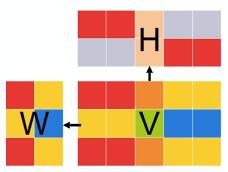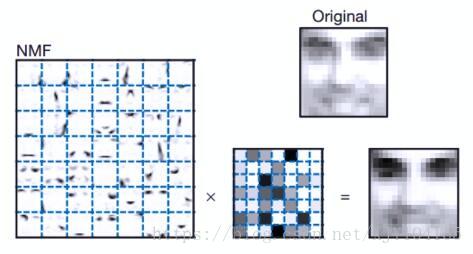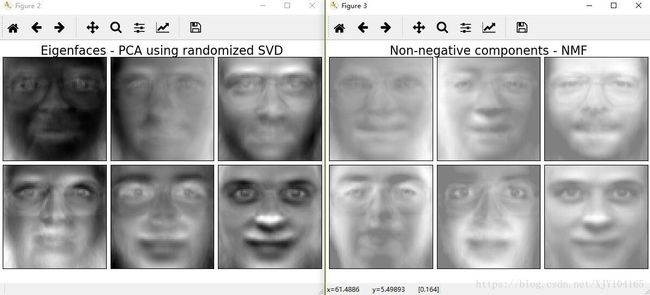Python机器学习应用-降维之NMF
非负矩阵分解(NMF)
非负矩阵分解(Non-negative Matrix Factorization,NMF)是在矩阵中所有元素均为非负数约束条件之下的矩阵分解方法。
基本思想:
给定一个非负矩阵 V V ,NMF能够找到一个非负矩阵 W W 和一个非负矩阵 H H ,使得矩阵 W W 和 H H 的乘积近似等于矩阵 V V 中的值。
Vn∗m=Wn∗k∗Hk∗m V n ∗ m = W n ∗ k ∗ H k ∗ m
N优化目标:
最小化 W W 矩阵 H H 矩阵的乘积和原始矩阵之间的差别。
argmin12||X−WH||2=12∑i,j(Xij−WHij)2 a r g min 1 2 | | X − W H | | 2 = 1 2 ∑ i , j ( X i j − W H i j ) 2
基于KL散度的优化目标,损失函数如下:
argminJ(W,H)=∑i,j(XijlnXijWHij−Xij+WHij) a r g min J ( W , H ) = ∑ i , j ( X i j ln X i j W H i j − X i j + W H i j )
sklearn中NMF:
在sklearn库中,可以使用sklearn.decomposition.NMF加载NMF算法,主要参数有:
- n_components:用于指定分解后矩阵的单个维度k;
- init: W W 矩阵和 H H 矩阵的初始化方式,默认为‘nndsvdar’。
实例:NMF人脸数据特征提取
目标:
已知Olivetti人脸数据共400个,每个数据是64*64大小。由于NMF分解得到的 W W 矩阵相当于从原始矩阵中提取的特征,那么就可以使用NMF对400个人脸数据进行特征提取。
通过设置k的大小,设置提取的特征的数目。在本实验中设置k=6,随后将提取的特征以图像的形式展示出来。

实例程序编写:
1 建立工程。导入sklearn相关工具包:
from numpy.random import RandomState
import matplotlib.pyplot as plt
from sklearn.datasets import fetch_olivetti_faces
from sklearn import decomposition2 设置基本参数并加载数据
n_row, n_col = 2, 3 #设置图像显示时的排列情况,如右图
n_components = n_row * n_col #设置提取的特征数目
image_shape = (64, 64) #
dataset = fetch_olivetti_faces(shuffle=True, random_state=RandomState(0))
faces = dataset.data #加载数据并打乱顺序3 设置图像的展示方式:
def plot_gallery(title, images, n_col=n_col, n_row=n_row):
plt.figure(figsize=(2. * n_col, 2.26 * n_row))
plt.suptitle(title, size=16)
for i, comp in enumerate(images):
plt.subplot(n_row, n_col, i + 1)
vmax = max(comp.max(), -comp.min())
plt.imshow(comp.reshape(image_shape), cmap=plt.cm.gray,
interpolation='nearest', vmin=-vmax, vmax=vmax)
plt.xticks(())
plt.yticks(())
plt.subplots_adjust(0.01, 0.05, 0.99, 0.94, 0.04, 0.)4 创建特征提取的对象NMF,使用PCA作为对比:
estimators = [
('Eigenfaces - PCA using randomized SVD',
decomposition.PCA(n_components=6,whiten=True)),
('Non-negative components - NMF',
decomposition.NMF(n_components=6, init='nndsvda', tol=5e-3))5 降维后数据点的可视化:
for name, estimator in estimators:
print("Extracting the top %d %s..." % (n_components, name))
print(faces.shape)
estimator.fit(faces)
components_ = estimator.components_
plot_gallery(name, components_[:n_components])
plt.show()附件
from numpy.random import RandomState
import matplotlib.pyplot as plt
from sklearn.datasets import fetch_olivetti_faces
from sklearn import decomposition
n_row, n_col = 2, 3
n_components = n_row * n_col
image_shape = (64, 64)
###############################################################################
# Load faces data
dataset = fetch_olivetti_faces(shuffle=True, random_state=RandomState(0))
faces = dataset.data
###############################################################################
def plot_gallery(title, images, n_col=n_col, n_row=n_row):
plt.figure(figsize=(2. * n_col, 2.26 * n_row))
plt.suptitle(title, size=16)
for i, comp in enumerate(images):
plt.subplot(n_row, n_col, i + 1)
vmax = max(comp.max(), -comp.min())
plt.imshow(comp.reshape(image_shape), cmap=plt.cm.gray,
interpolation='nearest', vmin=-vmax, vmax=vmax)
plt.xticks(())
plt.yticks(())
plt.subplots_adjust(0.01, 0.05, 0.99, 0.94, 0.04, 0.)
plot_gallery("First centered Olivetti faces", faces[:n_components])
###############################################################################
estimators = [
('Eigenfaces - PCA using randomized SVD',
decomposition.PCA(n_components=6,whiten=True)),
('Non-negative components - NMF',
decomposition.NMF(n_components=6, init='nndsvda', tol=5e-3))
]
###############################################################################
for name, estimator in estimators:
print("Extracting the top %d %s..." % (n_components, name))
print(faces.shape)
estimator.fit(faces)
components_ = estimator.components_
plot_gallery(name, components_[:n_components])
plt.show()

